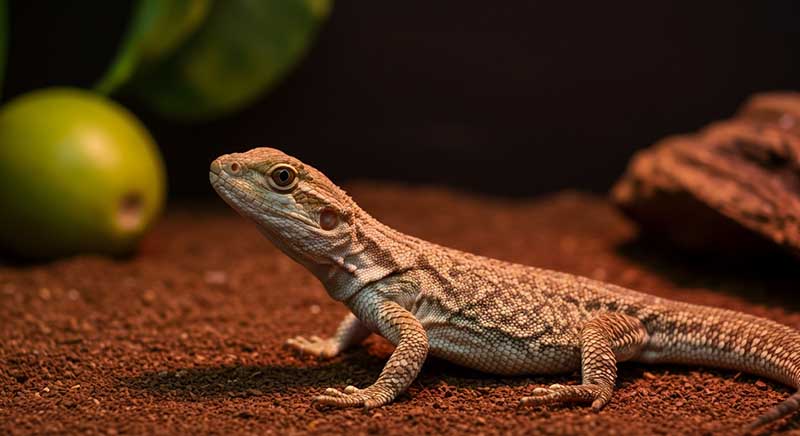Reptiles are ectothermic animals, meaning they depend on external heat sources to regulate their body temperature. While controlled heat is essential for digestion, immunity, and general health, excessive heat can quickly become life-threatening. Overheating can lead to dehydration, organ stress, behavioral issues, and even death if not addressed promptly. Understanding how to balance heat in your reptile’s enclosure is one of the most important responsibilities of reptile ownership.
This in-depth guide provides strategies to prevent overheating in reptile enclosures by combining equipment control, environmental management, behavioral monitoring, and seasonal adjustments. Whether you’re keeping bearded dragons, geckos, snakes, or chameleons, these techniques can help you maintain a safe and stable environment for your reptilian companion.
1. Understand Species-Specific Temperature Requirements
Every reptile has a unique preferred temperature range based on its natural habitat:
- Desert Reptiles (e.g., Bearded Dragons): Basking 95–110°F, cool side 75–85°F.
- Tropical Reptiles (e.g., Green Iguanas): Ambient 80–90°F with basking up to 100°F.
- Nocturnal Species (e.g., Leopard Geckos): Warm side 88–92°F, cool side 75–80°F.
- Snakes (e.g., Ball Pythons, Corn Snakes): Basking 88–92°F, cool side 75–80°F.
Research the ideal temperature gradient and humidity for your reptile species and life stage (juvenile vs. adult) to set the correct environmental parameters.
2. Invest in Thermostats and Timers for Heat Regulation
Using thermostats is the best way to prevent dangerous temperature spikes:
- Thermostats: Control heating devices like heat lamps, ceramic emitters, and under-tank heaters (UTH).
- Dimming or Pulse Proportional Thermostats: Ideal for radiant heaters, offering smoother temperature control.
- Timers: Help simulate natural day/night cycles by turning heat or light off at night or reducing intensity.
Thermostats prevent equipment from overheating the enclosure and allow precise control over your reptile’s heating zones.
3. Monitor with Reliable Thermometers and Temperature Guns
Don’t rely on a single thermometer—multiple readings ensure better control:
- Digital Thermometers with Probes: Place one on the basking spot, another in the cool zone.
- Infrared Temperature Guns: Measure surface temperatures quickly and accurately across basking zones and hides.
- Thermo-Hygrometers: Combine temperature and humidity monitoring, especially important for tropical reptiles.
Record temperatures throughout the day and night to detect fluctuation trends.
4. Create and Maintain a Thermal Gradient
A thermal gradient allows reptiles to thermoregulate naturally:
- Basking Zone: Place heat source on one end.
- Cool Zone: Leave the opposite end unheated.
- Hide Placement: Provide hides on both warm and cool sides for comfort and safety.
Avoid using a heat source that radiates evenly across the entire enclosure, which can eliminate the gradient.
5. Improve Ventilation and Air Circulation
Good airflow reduces heat retention:
- Screen Lids: Allow excess heat to escape.
- Cross Ventilation: Some enclosures offer front and side vents to promote better air movement.
- Room Fans: Circulate room air gently (not directed at the reptile).
- AC or Dehumidifiers: Useful in humid climates or during hot summers.
Avoid sealed or poorly ventilated tanks that trap heat and humidity.
6. Avoid Direct and Indirect Sunlight Exposure
Sunlight can turn an enclosure into an oven within minutes:
- Never place tanks near windows.
- Use blackout curtains, blinds, or UV-filtering window film if needed.
- Reflective surfaces near the tank can intensify sunlight and should be avoided.
Check room temperature during sunny hours to determine if passive heat is affecting the enclosure.
7. Adapt to Seasonal Weather Changes
Warmer seasons require adjustments in heating strategy:
- Summer Tips:
- Lower thermostat settings.
- Turn off secondary heat sources during the day.
- Increase water availability through bowls or misting.
- Winter Tips:
- Monitor for underheating due to cold drafts.
- Insulate the enclosure with foam panels or thermal blankets if needed.
Be proactive with seasonal transitions and monitor how they affect room and enclosure temperatures.
8. Choose Enclosure Materials Wisely
The construction of the habitat affects heat retention:
- Glass Tanks: Heat up quickly and radiate heat unevenly.
- PVC or Melamine Enclosures: Provide better insulation and temperature stability.
- Screen Cages (for Arboreal Reptiles): Offer excellent ventilation but may require supplemental heating.
Match the enclosure material to the species and local climate to reduce heat retention risks.
9. Add Cooling Elements When Necessary
When ambient temperatures are high, additional cooling strategies can prevent overheating:
- Use frozen water bottles or ceramic tiles chilled in the fridge.
- Drape damp towels over part of the screen lid (avoid electrical contact).
- Place cooling pads or fans near the enclosure (safe from contact with pets).
- Mist more frequently for tropical species to help with evaporative cooling.
Always ensure that cooling efforts do not drop temperatures below species requirements.
10. Watch for Behavioral Signs of Overheating
Your reptile’s behavior is a reliable early-warning system:
- Panting or Gaping: An effort to release excess body heat.
- Constant Hiding or Avoiding Basking Area: Indicates discomfort.
- Flattening Against Cool Surfaces: Trying to dissipate heat.
- Lethargy or Unusual Aggression: May signal distress.
If you notice any of these symptoms, check the temperature immediately and cool the enclosure gradually.
11. Prepare for Emergencies and Power Outages
Emergencies can lead to dangerous conditions:
- Overheating Emergency Kit:
- Frozen bottles, portable fans, thermometer, battery-powered thermostat.
- Plan for Heatwaves:
- Move enclosure to a cooler room or basement.
- Close blinds and reduce ambient light.
Stay informed about weather changes and act early to prevent heat buildup.
A Balanced Environment is a Healthy One
Preventing overheating in reptile enclosures is essential for ensuring your reptile’s comfort, health, and survival. A balance of heat, airflow, humidity, and lighting creates a stress-free habitat where your pet can thrive. By using thermostats, observing behavior, and making seasonal adjustments, you can maintain the ideal conditions year-round.
Every reptile keeper should strive for consistency, adaptability, and attentiveness. Watch how your pet interacts with its environment, learn from its signals, and continue fine-tuning the setup. A well-regulated enclosure is one of the best gifts you can give your scaly companion.

